What if I told you that you can turn your home oven into a
What Is a Pizza Steel ?
A
Who Needs a Pizza Steel ?
If you want to recreate the crispy, charred crust from an Italian pizzeria at home, you need a
There are other alternatives, such as pizza stones and pizza pans, but a
Everyone that’s serious about pizza baking and wants to elevate their pizza game should own a
How Does a Pizza Steel Work?
The main challenge of baking pizza in a regular home oven is that it takes way longer than in a
Retaining heat, simply means that the steel holds on to the heat well when you heat it and can stay hot for a long period of time. But what makes a
The conductivity and ability to retain heat is a killer combo to bake pizza faster, at a higher temperature. And this is why a
How Baking in a Neapolitan Pizza Oven Works
In a traditional Neapolitan wood-fired
According to the AVPN (The True Neapolitan Pizza Association), which manages the International Neapolitan Pizza Regulations, Neapolitan pizza should be baked in a wood-fired oven at 905°F (485°C) for only 60-90 seconds. This will give you the unique texture of Neapolitan pizza crust: a crispy exterior and a soft and airy interior.
A wood-fired oven bakes the bottom of the pizza by direct contact with the hot floor of the oven.
The ceiling of the oven is usually dome-shaped, which lets the heat from the burning fire circulate and reflect from the ceiling to bake the pizza.
The pizza is therefore baked with a combination of direct contact with the hot floor and the radiating heat from the ceiling of the oven.
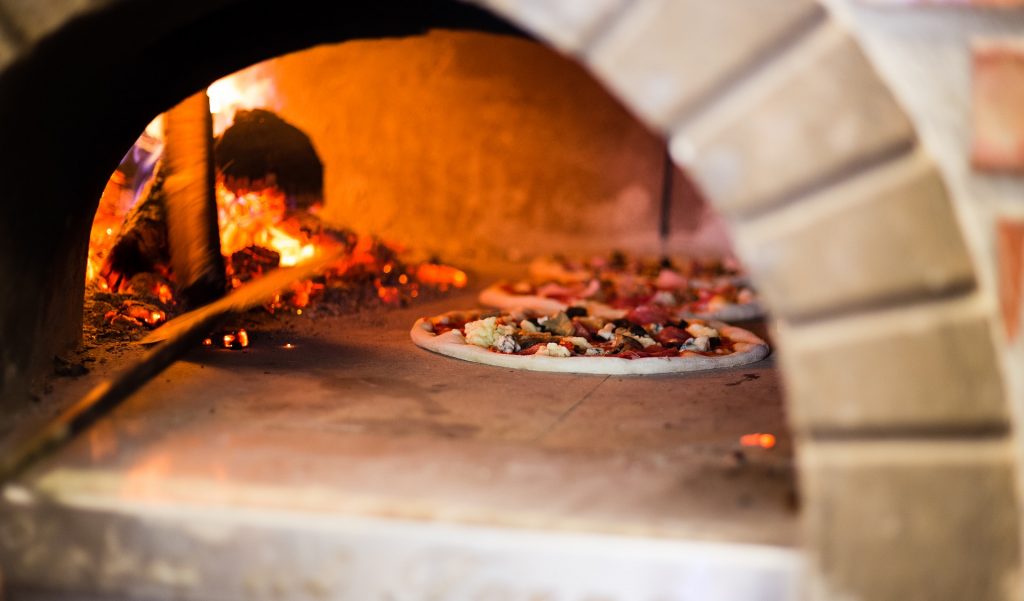
It needs to be balanced between the baking of the top and bottom of the pizza. Otherwise, you’ll end up with a burnt crust and an undercooked top, or vice versa.
The temperature is the main challenge when you bake pizza at home. Because most home ovens can’t reach anywhere near 905°F (485°C). This means you have to increase the baking time for the pizza to get it crispy. And the result is a dryer crust and often overcooked toppings.
When you bake your pizza for 10-15 minutes or more, too much water will evaporate from the dough, leaving you with a dry pizza crust. Baking at these lower temperatures will also give you less oven puff, and you’ll get a more dense crust, rather than light and soft with large bubbles.
The solution is to bake pizza on a
How a Pizza Steel Can Achieve the Same in a Home Oven
In short, the reason a
When you heat a
Another thing that makes baking on a
When you preheat the steel, you should use the highest setting for your oven to get the steel as hot as possible. And if your oven has a broiler or grill element, I recommend using that too, to further increase the heat. A broiler gets super hot, and is also useful to bake the top of the pizza.
Pizza Steel Materials
Pizza steels are most commonly made from stainless steel. You can also find pizza steels made from carbon steel or cast iron. These are less common, and also more prone to rust, and therefore require more maintenance.
Is a Pizza Steel Better?
The short answer is yes, a
Pizza Steel vs Pizza Stone
A pizza stone works similarly to a
Part of the reason stone is used in a wood-fired oven is that it transfers heat more slowly. Because you don’t want the pizza to bake too fast. But in a home oven, this is a disadvantage.
A pizza stone does however retain heat better than steel. Which means it can hold on to the heat longer. This is a benefit when baking multiple pizzas right after each other.
A pizza stone will not bake pizza as fast, not make as crispy pizza, but can handle more pizzas baked right after each other. (More about pizza stone materials here)
Pizza stones are usually cheaper and can be obtained as cheaply as 25 dollars. A stone is therefore an affordable way to get started with Neapolitan pizza baking at home.
A major disadvantage of pizza stones is that they tend to crack. Especially the cheap, thin stones. Another disadvantage of pizza stones is that they are much harder to clean.
I’ve written an in-depth comparison between pizza steels and pizza stones if you want to know more.
Pizza Steel vs Pizza Pan
Another alternative is a pizza pan. Usually, a flat disc is made from metal that you place the pizza in before transferring it into the oven. Pizza pans are convenient and easier to use than stone or steel but don’t make as crispy pizza.
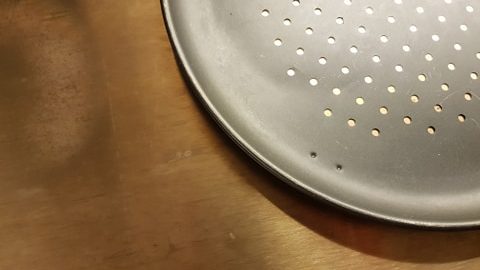
The major disadvantage of using a pizza pan is that it’s placed cold in the oven. This means the pizza will not bake as fast as on a pizza stone or
Baking pizza in a pizza pan is, therefore, more comparable to baking on a baking tray, rather than a
Pizza Steel vs Cast-Iron Skillet
You can also make crispy pizza using a cast-iron skillet. Simply preheat the oven, place the pizza in the skillet on the stovetop to bake the bottom, and move it into the hot oven. Even though you can make crispy pizza in a cast-iron pan, it’s hard to get a fast bake unless you place the dough into a hot cast-iron skillet. Something that can be dangerous! It’s also harder to make many pizzas using a cast-iron skillet because that requires many skillets (something most of us don’t have).
You can get a crispy, charred pizza in a cast iron pan, but it’s not as easy as using a
Pizza Steel Benefits
To sum it up, here are the main benefits of a
- Conducts heat well; baking pizzas faster and hotter than you can otherwise do in a regular home oven
- Retains heats well; allows baking of several consecutive pizzas
- Ease of use
- Requires little care and is easy to clean
- Will last you a lifetime, and is almost impossible to break!
A
Pizza Steel Price
The price ranges from around 30-150 dollars, depending on size, thickness, and quality. For a decent steel, you can expect to pay around 100 dollars.
Pizza Steel Thickness – How Thick Should a Pizza Steel Be?
The optimal thickness depends on your oven temperature, but for most home ovens the best
Generally, a thicker
But you need to keep the balance between baking the top and bottom of the pizza in mind. Hotter is not necessarily better if your oven temperature can’t keep up with the
The thickness also affects how many pizzas you can bake right after each other without re-heating the steel. The reason is that a thick
How Thickness Affects Baking Time
A thicker baking steel will bake slightly faster at the same oven temperature. In the table below, you can see an example of how the baking time differs for different thicknesses at the same oven temperature:
| Thickness | Baking time at 550°F (275°C) |
| 3/16 inch (4.8 mm) | 6-8 minutes |
| 1/4 inch (6.4 mm) | 5-7 minutes |
| 3/8 inch (9.5 mm) | 4-6 minutes |
| 1/2 inch (12.7 mm) | 3-5 minutes |
As you can see, the thicker the steel, the closer we get to the 60-90-second bake of a wood-fired oven. But thickness alone is not the only factor for the optimal bake.
How to Pick the Right Thickness
The optimal thickness depends on how hot your oven can get. And whether it has a broiler or not. Even though a thicker baking steel bakes pizza faster, the oven needs to keep up with the baking speed of the baking steel to avoid burning the bottom of the pizza.
So, the hotter your oven can get, the thicker steel you can use. Here’s a table that shows the optimal thickness for different oven temperatures:
| Temperature °F | Temperature °C | Recommended |
| 500°F | 250°C | 1/4-3/8 inch |
| 550°F | 275°C | 3/8-1/2 inch |
| 600°F | 300°C | 1/2 inch |
Most home ovens can reach a temperature of 500-550°F (250-275°C), the optimal thickness is therefore 3/8 – 1/2 inches. But if you have a hotter oven, I recommend 1/2 inch or more. This will give you an even faster bake!
I’ve also written an in-depth guide about pizza steel thickness if you want to know more about how the thickness affects the baking time, and how to pick the best thickness for your oven.
What Is the Best Pizza Steel ?
Most pizza steels will give you an amazing crispy result, and be miles better than baking pizza on a baking tray. But I’ve tried to collect the best options for you here.
The Overall Best Pizza Steel
The best overall
Many pizza steels are too thin. This will not make crispy, charred pizza, but rather soggy and undercooked. With too thin baking steels, you also need to reheat it between every pizza. That is however not the case for the Conductive Cooking Square!
With a thickness of 3/8 inches, it transfers heat efficiently and will bake crispy pizza in just a few minutes.
It also retains heat well, meaning it holds onto the heat for a long time. You can therefore easily bake 2-3 pizzas right after each other without re-heating the steel.
3/8 inches is the perfect all-around thickness, that’s going to bake great pizza in any home oven. But the Conductive Cooking Square also comes in a 3/16 inch version (affiliate link), in addition to different dimensions.
The reason I recommend the Conductive Cooking Square Deluxe is that it’s incredibly durable and solid
The Best Thick Pizza Steel for Faster Bake
The best thick
With a 1/2-inch thick steel, you’ll get a super quick bake. And you’ll turn out crispy, blistered pizzas in only 3-5 minutes. Something I’ve never seen from any other home oven baking method. This is honestly the closest you’ll get to wood-fired Neapolitan pizza without actually using a
The thickness also allows the baking of several consecutive pizzas without reheating.
Another benefit of thicker pizza steels is even cooking. The thicker it is, the more even heat distribution you’ll get. This will ensure an even bake of the pizza crust.
The steel also comes with handy finger holes that make it easier to move. Something that can be challenging with baking steel as heavy as the NerdChef Steel Stone.
It also comes pre-seasoned, with a super smooth surface. Something that will prevent sticking.
The NerdChef Steel Stone is the perfect
With the NerdChef Steel Stone, you don’t need a wood-fired
The Best Budget Option
The best budget
The only difference between the Standard and the Deluxe version is the thickness. This means this US-made baking steel is made from the same quality materials and has the same nice finish as the Deluxe version.
Since it’s a bit thinner, it will not bake the pizza as fast as the Deluxe version, but you can still get crispy, charred pizza in your home oven!
How to Use a Pizza Steel
Baking pizza on a
1. Place the Pizza Steel in the Oven
First, place the
If your oven has a broiler or grill element in the ceiling of the oven, I recommend placing the steel around 2 inches (5cm) from the broiler. To get that close, you probably have to place the steel on the top rack of your oven. The reason is that the broiler gets really hot, often way hotter than the 500-550F most home ovens can reach. That extra heat will bake the pizza in only a few seconds, and even make the iconic leopard pattern you find on wood-fired Neapolitan pizza
2. Preheat the Pizza Steel
Next, preheat the oven and steel for at least 45 minutes to 1 hour. If you have a thick
3. Prepare the Pizza
Stretch out the dough and shape it into a thin disk with a raised rim.
On your kitchen counter, add sauce, cheese, and toppings. But make sure not to overtop your pizza, as this will increase the baking time, and additional moisture can prevent the crust from crisping.
4. Transfer the Pizza Into the Oven
To transfer the pizza into the oven, I recommend using a pizza peel. Lightly dust the peel with semolina, and carefully drag the pizza from the countertop to the peel. You want to leave the pizza on the peel for as short as possible to prevent sticking.
Do the last adjustments to the shape of the pizza. Then, move the peel to the super-hot baking steel. Then slide the pizza of the peel onto the baking surface.
5. Bake the Pizza
Depending on the temperature of your oven and how thick your
The pizza is done when the cheese is melted, and the crust has started to brown and has some leoparding. You don’t want to leave it any longer, because the crust may dry out if you leave it too long. Get your
6. Serve the Pizza
Time to serve your amazing Neapolitan-style pizza! Either place it directly on a large plate and serve, or on a wooden cutting board for cutting it into slices. Enjoy!
7. Let the Pizza Steel Cool Completely Before Cleaning and Storage
The last step is to let the
More About Using Your Pizza Steel
If you want to know more about how to use a
How to Clean a Pizza Steel
After you’re done baking, it’s time to clean up. The steel may contain burned cheese, sauce, and other food soils that can be challenging to get rid of.
Before you get started, your baking steel must cooled. Never try to clean a hot
Start by getting rid of food burnt food. Due to the high heat, most of the larger pieces turn into ashes and should come off easily. If you have some tougher ones, you can use a spatula or your oven’s self-cleaning function, if it has one.
Then remove any loose residue using a nylon brush and hot water. For extra tough spots, you can use steel wool, or even better, the EarthStone Cleaning Block should get them right off.
You should not use soap. Harsh soap and other types of detergent are not good for your baking steel. You should also avoid leaving it under running water, as this may cause it to rust. You should also never place the
After cleaning, dry the steel completely, you don’t want to leave any moisture on the steel when you’re storing it. Every once in a while you should also season the steel.
For a complete guide, check out: How to Clean a Pizza Steel – Easy Step-by-Step Guide.
How to Season a Pizza Steel
To make your
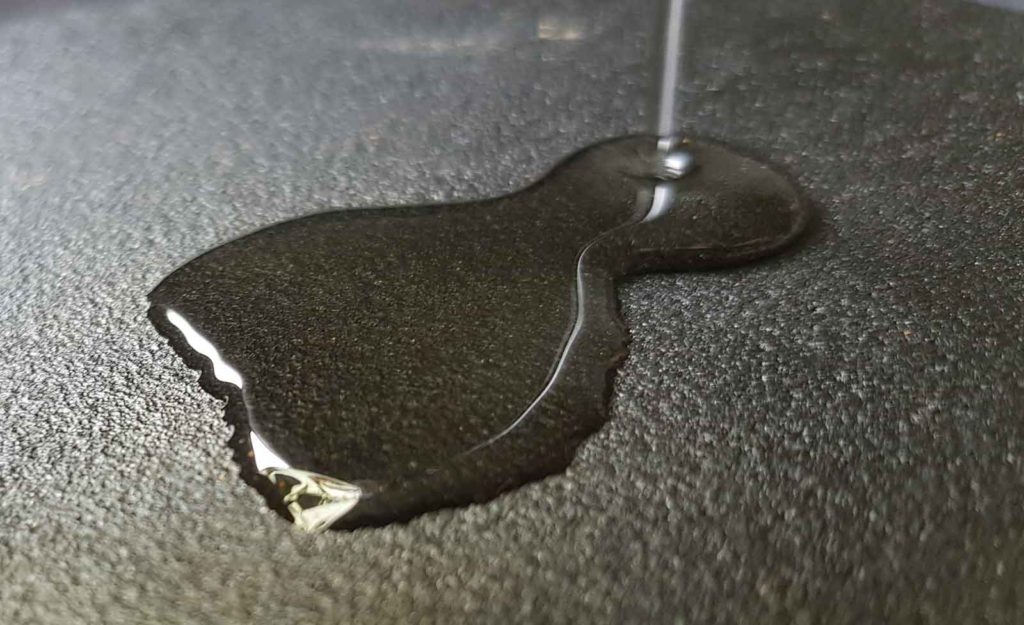
What is Seasoning?
Seasoning is the process of adding a high smoke point oil, followed by exposing the
What You Need to Season a Pizza Steel
To season the steel, you need a neutral, high smoke point oil. The oil should be neutral to avoid adding flavor to your pizza when you later use the steel. The reason you need a high smoke point oil is to prevent burning when you heat the oil during the seasoning process. A high smoke point is defined as 350°F (175°C) or higher. Examples of high smoke point oils for seasoning are:
- Coconut oil
- Grapeseed, oil
- Peanut oil
- Canola oil
- Sunflower oil
You also need an oven that can reach 350°F (175°C) to heat the steel in.
When Do You Need to Season a Pizza Steel
Most pizza steels come pre-seasoned when you buy them, so you don’t need to season the steel the first time you use it.
How often you need to season the steel depends on how frequently you use it, but generally, I recommend seasoning every 3-6 months (2-4 times a year).
Seasoning Step-by-Step
1. Clean The Pizza Steel
Before you season, you should clean your
2. Apply a Thin Layer of Oil
Spread a thin layer of oil on the surface of the
3. Bake the Steel in the Oven
Next, place the
During baking, the steel can get darker but don’t worry, this is natural. When you use, and especially when you season, your
4. Let Cool Completely
When the time is up, leave the piss steel in the oven to cool, before you take it out. I recommend leaving it in the oven for a few hours, or overnight.
For the full guide on seasoning, check out: How to Season Your Pizza Steel to Make It Last
How to Store a Pizza Steel
Your
How to Remove Rust From a Pizza Steel
To remove rust from your, simply sand the steel with fine-grit sandpaper (affiliate link). I recommend 800 grit, but if the rust goes deep into the steel, you may need lower-grit sandpaper.
You should re-season your baking steel after you’ve removed the rust to add a protective layer. This will prevent the steel from rusting.
Pizza Dough for Pizza Steel
You can bake any kind of pizza on your
Neopolitan-Style Pizza Dough
Due to the heat and fast baking time, the perfect dough for your
Traditional Neapolitan pizza is designed specifically for a quick, hot bake in a blazing hot oven. Neapolitan pizza is therefore made with a lean dough, meaning the dough doesn’t contain any fat, such as olive oil. Oil is conducting heat well, and will therefore increase the baking speed. In a wood-fired oven, this is not a benefit, since the pizza most likely will burn too fast. But at home, especially if your oven doesn’t get that hot, I recommend playing around with the addition of oil to make the pizza bake faster.
Neapolitan pizza is also usually made with low dough hydration (55-62% hydration). Dough hydration is simply the amount of water compared to flour in the dough expressed in percentages. The reason Neapolitan pizza dough has that low hydration is that little water will have time to evaporate from the dough during the fast bake.
Neapolitan-Style Pizza in a Home Oven
Since your home oven doesn’t get as hot as a wood-fired
Neapolitan pizza has a light open crust. This can be replicated using a higher hydration dough. I, therefore, recommend increasing the hydration of your dough when you bake pizza in a home oven. A great starting point is 65% hydration (65g of water for every 100g of flour in your dough). This will give a more open crust with larger bubbles. Higher hydration will also make the exterior of the crust crispier. You can read more about Neapolitan pizza dough hydration here.
I’ve also made a simple pizza dough calculator to make it easier to adjust the size and hydration of your pizza dough!
New-York-Style Pizza Dough
Another great option is New York-style pizza, which also is a thin pizza baked quickly at high temperatures.
New York-style pizza is also great to bake on a
What Else Can You Use a Pizza Steel For?
Despite the name, pizza steels have lots of different applications besides pizza baking. You can bake a variety of different foods, ranging from baked goods, such as cakes and bread to meat. The conduciveness and heat from the steel give you some unique ways of using your oven. But pizza steels don’t need to be used in an oven.
Baking Bread
A
Searing Meat
Hot steel is also great for searing meat. Either in the oven or used as a griddle on the grill.
Ice Cream on a Pizza Steel
Another, lesser-known, use of a
Pizza Steel Q&A
What Is a Pizza Steel Made Of?
Steel. It can be made of different types of metal alloys, carbon steel, cast iron, or most commonly stainless steel.
Where in the Oven Should You Place a Pizza Steel ?
You should place the
How Long to Preheat a Pizza Steel ?
You should preheat a
How Thick Should A Pizza Steel Be?
For most ovens, it should be 3/8 – 1/2 inches (9.5 – 12.7 mm) thick for the optimal bake.
How Heavy is a Pizza Steel ?
Most pizza steels are heavy, and most of them are between 15 and 30 pounds (7-14 kg).
Can You Put a Pizza Steel in the Dishwasher?
No! You should never clean your
Related
- Is Your Pizza Dough Too Dry? Here is How to fix it! - June 10, 2024
- The Ultimate Guide to the Pizza Dough Windowpane Test - June 8, 2024
- The Ultimate Guide to Autolyse Pizza Dough - June 7, 2024




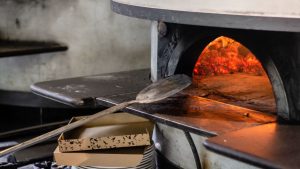
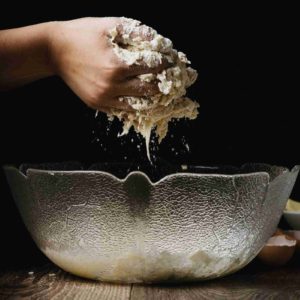

I see that you recommend the Nerd Chef Steel Stone. Have you tried the Nerd Chef Speed Steel? It is described on their home page. It is 14.5” X 13.5” X .90”- 15LBS, so much thicker than the Steel Stone, but weighs less, I guess because it is made out of cast steel. This means it would be more prone to rusting right?
It has these fins on the underside which Nerd Chef claims provide better heat distribution.
It is about $50 cheaper than the Steel Stone.
Please reply if you have any feedback. Thanks!
Hi! No, I haven’t tried the Nerd Chef Speed Steel, so I can’t really comment on this product. Baking pizza on in a cast-iron skillet works well, so I would imagine you can make great pizza on the Nerd Chef Speed Steel as well. But you’re right when it comes to rust. Cast iron does require a bit more care than a stainless steel stone.
In case you or your readers are interested, Nerd Chef got back to me with the following details, which convince me that the Steel Stone is superior to the Speed Steel:
The .375 Steel Sone has 50% more steel (the cast Speed Steel is not solid), a bigger surface, 50% higher heat capacity, can cook pizzas faster, and takes less time to heat up between pizzas.
Hello, I can’t tell from this post whether if I am supposed to cook my pizza on the broiler setting or on the bake setting? I get that I preheat on bake then the last 15 minutes, set to broiler but should I set it bake to bake setting to cook the pizza? Please advise. Thanks.
Wow, fantastic article. This really helped me understand a lot of the science and rationale behind using metal vs stone. Now I appreciate why we don’t need the ultra high temps to get a crispy crust and why cooking with a steel in those 800f+ temps would result in burning of the dough (not to mention destroying the metal’s seasoning)